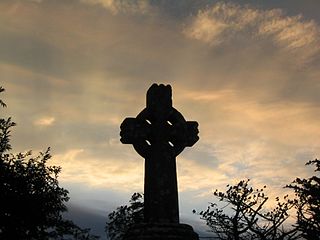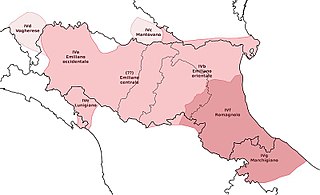Related Research Articles

Celtic Christianity is a form of Christianity that was common, or held to be common, across the Celtic-speaking world during the Early Middle Ages. Some writers have described a distinct Celtic Church uniting the Celtic peoples and distinguishing them from adherents of the Roman Church, while others classify Celtic Christianity as a set of distinctive practices occurring in those areas. Varying scholars reject the former notion, but note that there were certain traditions and practices present in both the Irish and British churches that were not seen in the wider Christian world.
The Primacy of Ireland was historically disputed between the Archbishop of Armagh and the Archbishop of Dublin until finally settled by Pope Innocent VI. Primate is a title of honour denoting ceremonial precedence in the Church, and in the Middle Ages there was an intense rivalry between the two archbishoprics as to seniority. Since 1353 the Archbishop of Armagh has been titled Primate of All Ireland and the Archbishop of Dublin Primate of Ireland, signifying that they are the senior churchmen in the island of Ireland, the Primate of All Ireland being the more senior. The titles are used by both the Catholic and Church of Ireland bishops. The distinction mirrors that in the Church of England between the Primate of All England, the Archbishop of Canterbury, and the Primate of England, the Archbishop of York.

Faenza is an Italian city and comune in the province of Ravenna, Emilia-Romagna, situated 50 kilometres southeast of Bologna.

Saint Kilian, also spelled Killian, was an Irish missionary bishop and the Apostle of Franconia, where he began his labours towards the end of the 7th century. His feast day is 8 July.

August 7 - Eastern Orthodox liturgical calendar - August 9

August 17 - Eastern Orthodox liturgical calendar - August 19

January 6 - Eastern Orthodox liturgical calendar - January 8

January 7 - Eastern Orthodox liturgical calendar - January 9

Saint Fursey was an Irish monk who did much to establish Christianity throughout the British Isles and particularly in East Anglia. He reportedly experienced angelic visions of the afterlife. Fursey is one of the Four Comely Saints.

Saint Patrick was a fifth-century Romano-British Christian missionary and bishop in Ireland. Known as the "Apostle of Ireland", he is the primary patron saint of Ireland, the other patron saints being Brigit of Kildare and Columba. Patrick was never formally canonised, having lived prior to the current laws of the Catholic Church in these matters. Nevertheless, he is venerated as a Saint in the Catholic Church and in the Eastern Orthodox Church, where he is regarded as equal-to-the-apostles and Enlightener of Ireland. He is also regarded as a Saint within the framework of their respective doctrine by the Anglican Communion and the Lutheran Churches.

The Roman Catholic Diocese of Ossory is a Roman Catholic diocese in eastern Ireland. It is one of three suffragan dioceses in the ecclesiastical province of the Metropolitan Archbishop of Dublin. Most recently it was led by Dermot Farrell, who was appointed on 3 January 2018 and ordained bishop on 11 March 2018. He was appointed Archbishop of Dublin on 29 December 2020 and remained Apostolic Administrator of Ossory until 2 February 2021.

The Diocese of Faenza-Modigliana is a see of the Catholic Church in Italy. It was created in 1986 through a merger of the diocese of Faenza and the diocese of Modigliana.
Emilia is a historical region of northern Italy, which approximately corresponds to the western and north-eastern portions of the modern region Emilia-Romagna, with the area of Romagna forming the remainder of the modern region.

Christianity is, and has been the largest religion in Ireland since the 5th century. After a pagan past of Antiquity, missionaries, most famously including Saint Patrick, converted the Irish tribes to Christianity in quick order, producing a great number of saints in the Early Middle Ages, and a faith interwoven with Irish identity for centuries since − though much less so in recent times.

Saint Fridianus, was an Irish prince and hermit, fl. 6th century. Tradition names him as a son of King Ultach of Ulster. He later migrated to Italy, where he was appointed as Bishop of Lucca. The Basilica of San Frediano in the city is dedicated to him, as are churches in Florence.

Romagnol dialects (rumagnòl) are a group of closely-related dialects spoken in the historical region of Romagna, which is now in the south-eastern part of Emilia-Romagna, Italy. The name is derived from the Lombard name for the region, Romania. Romagnol is also spoken outside the region, particularly in the Provincia di Pesaro e Urbino and in the independent country of San Marino. It is classified as an endangered language because older generations have "neglected to pass on the dialect as a native tongue to the next generation".

In the 5th century in Christianity, there were many developments which led to further fracturing of the State church of the Roman Empire. Emperor Theodosius II called two synods in Ephesus, one in 431 and one in 449, that addressed the teachings of Patriarch of Constantinople Nestorius and similar teachings. Nestorius had taught that Christ's divine and human nature were distinct persons, and hence Mary was the mother of Christ but not the mother of God. The Council rejected Nestorius' view causing many churches, centered on the School of Edessa, to a Nestorian break with the imperial church. Persecuted within the Roman Empire, many Nestorians fled to Persia and joined the Sassanid Church thereby making it a center of Nestorianism. By the end of the 5th century, the global Christian population was estimated at 10-11 million. In 451 the Council of Chalcedon was held to clarify the issue further. The council ultimately stated that Christ's divine and human nature were separate but both part of a single entity, a viewpoint rejected by many churches who called themselves miaphysites. The resulting schism created a communion of churches, including the Armenian, Syrian, and Egyptian churches, that is today known as Oriental Orthodoxy. In spite of these schisms, however, the imperial church still came to represent the majority of Christians within the Roman Empire.

December 5 - Eastern Orthodox liturgical calendar - December 7
Peter Damian was a reforming Benedictine monk and cardinal in the circle of Pope Leo IX. Dante placed him in one of the highest circles of Paradiso as a great predecessor of Francis of Assisi and he was declared a Doctor of the Church in 1828. His feast day is 21 February.

March 6 - Eastern Orthodox liturgical calendar - March 8
References
- Irish "Peregrini" in Tuscany/Umbria/Lombardy, Professor Noel Mulcahy, in North Munster Antiquarian Journal (2005?), p. 134.